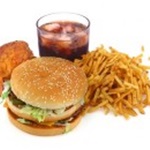Junk Food Facts and Its Effects
We define a junk food as, a food that is likely to do more harm than good to the body. We’ve used hot dogs as our, pardon the expression, model junk food. They’re high in saturated fats, hydrogenated fats, added sugars, additives, food colorings, nitrates, and nitrites.
The potentially harmful stuff in junk foods
Example: Beef jerky
High sodium, high percentage of saturated fat, high in nitrates and nitrites, added food colorings. Colored, sweetened cereals hydrogenated oils, dyes: yellow #6, red #40, blue #2, blue #1 (Most don’t contain whole-grain flour, yet may display the American Heart Association’s heart-healthy seal of approval.)
Example: Doughnuts
White flour, hydrogenated oils, icing, lots of sugar Potato chips hydrogenated oils, high in salt.
Example: Gelatin desserts
Dyes, high sugar candies, hydrogenated oils, high sugar punch dyes, high sugar sodas, high sugar, caffeine, dyes, carbonation juice drinks or “cocktails” with very little juice, mostly corn syrup and other sweeteners
Example: Marshmallows
Mostly sugar, sticky for teeth
White is wrong!
Even though white is a symbol of purity, even health, when it comes to the nutritional value of foods, white has been black-listed. This is especially true in foods that have been man-made white by processing, such as white flour and white rice. In these two foods, the most nutritious brown part of the food (the bran; and in wheat, the germ) has been factory-removed by processing or bleaching and the colorless stuff that remains is nutrient-poor. Even a naturally white potato, though nutritious, is less so than its yellow friend, the sweet potato (which botanically really isn’t a potato). So, leave the white bread for the birds. Think brown.
Dr. Sears, or Dr. Bill as his “little patients” call him, has been advising busy parents on how to raise healthier families for over 40 years. He received his medical training at Harvard Medical School’s Children’s Hospital in Boston and The Hospital for Sick Children in Toronto, the world’s largest children’s hospital, where he was associate ward chief of the newborn intensive care unit before serving as the chief of pediatrics at Toronto Western Hospital, a teaching hospital of the University of Toronto. He has served as a professor of pediatrics at the University of Toronto, University of South Carolina, University of Southern California School of Medicine, and University of California: Irvine. As a father of 8 children, he coached Little League sports for 20 years, and together with his wife Martha has written more than 40 best-selling books and countless articles on nutrition, parenting, and healthy aging. He serves as a health consultant for magazines, TV, radio and other media, and his AskDrSears.com website is one of the most popular health and parenting sites. Dr. Sears has appeared on over 100 television programs, including 20/20, Good Morning America, Oprah, Today, The View, and Dr. Phil, and was featured on the cover of TIME Magazine in May 2012. He is noted for his science-made-simple-and-fun approach to family health.

